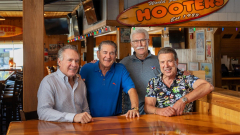A group of Florida friends thought it would be fun to open a restaurant in the 1980s that “they couldn’t get kicked out of.” Now in their 70s, they’re buying back franchises with a plan to restore the brand—from the signature wings to the orange shorts—to its cheeky glory.
Last winter, Neil Kiefer, CEO of the Original Hooters Founders Group, heard that the franchisor and operator of the Florida-based restaurant chain, known as Hooters of America, was about to go bankrupt. So the 73-year-old Kiefer, a longtime friend of the three living cofounders of the chicken wing empire, called them up and laid their options on the table.
The group’s 22 locations in Florida and Chicago were averaging $4.7 million in annual sales per location, Kiefer explained, while Hooters of America’s 150 locations were bringing in less than half that—$2.3 million each. Kiefer believed they could turn around the failing restaurants and made a bold proposal: “I can drop this whole thing and we’ll just exist as we have in the territories we have,” he told them, “or we can take a bigger risk.”
The original group—Gil DiGiannantonio, 77, Edward Droste, 74, and Dennis Johnson, 74—told Kiefer they were in. “We need to open a restaurant like a hole in the head,” Droste tells Forbes. “But we’ve always been America’s neighborhood oasis and, now more than ever, America needs us.”
Kiefer and the original Hooters crew could easily be enjoying their golden years on golf courses or the beaches of Florida. Instead, they are leading a deal to acquire 111 Hooters locations out of bankruptcy and planning to invest about $40 million into turning around the challenged chain. Kiefer, who was the cofounders’ attorney when Hooters was founded in Clearwater, Florida in 1983, says the group feels an emotional connection to the chain and don’t want to see the brand die.
“We had some soul searching,” says Kiefer. “We don’t want to leave the Hooters world in the condition it is in. We have a moral obligation.”
Sign Of The Timing: The founders’ corporate registration for Hooters arrived on April Fool’s Day 1983, which seemed appropriate to them because they had no restaurant experience.
courtesy of The Original Hooters Group
Last month, a Texas bankruptcy judge gave approval their plan, and final step is expected next week. Kiefer is now embarking on a transformation. That will start, he says, with Hooters returning to a more wholesome image. Nearly half of the 30 highest-volume Hooters restaurants in the U.S. are operated by Kiefer’s Hooters Inc. group. The design hews to the original “Florida themed beach shack” vibe with servers, known as Hooters Girls, in tight white t-shirts and (slightly) longer orange shorts. Kiefer believes the private equity owners of Hooters of America, Nord Bay Capital and TriArtisan Capital Advisor, “oversexualized the concept” by leaning into its reputation as a “breastaurant.” Kiefer’s group will acquire about 54 locations, while an operator called Hoot Owl LLC, which includes some of the first Hooters franchisees, will acquire another 57.
Coming back for seconds at Hooters won’t be easy. Says DiGiannantonio, who created the original Hooters menu: “If you had a bad day at work, you’d come into Hooters and feel good. If you had a great day at work, you’d come to Hooters and celebrate. They come back because the service is great. But the food has got to be there, too. So taking that back and making it right is going to be a challenge, but we’re ready for it.”
“It’s not a guaranteed slam dunk,” Kiefer admits. “We have to win customers back, and that’s not going to happen overnight just because the court says, Okay, take it over.”
Before the deal, the founders’ Hooters Inc. had estimated annual revenue of over $100 million, and healthy net profit margins that Forbes estimates at 7%. Tripling its footprint might supersize sales and profits, but it equally could be a disastrous financial drain.
Hooters bankruptcy follows several Chapter 11 filings from aging mid-sized restaurant chains in recent years, including Red Lobster, TGI Fridays and Buca Di Beppo, which have lost customers amid internal cost-cutting and an influx of new chains. Says former chairman of Buca Di Beppo and founder of Planet Hollywood Robert Earl, who acquired Buca Di Beppo in 2008 for $9.7 million and owned it until it filed for bankruptcy in 2024, which saw the Italian chain sold to its lender Main Street Capital Corp. for $27 million: “Who would have the best chance of getting it back to scratch? It’d be the founders.”
But Earl adds, “For legacy brands, it’s difficult to reinvent yourself—if it’s just the same white shirt and orange shorts, it’s not enough.”
In the early ‘80s, longtime friends and Clearwater businessmen—DiGiannantonio, a liquor salesman, Droste, a real estate executive, Johnson, a brick mason by trade, as well as L.D. Stewart, a painting contractor, Ken Wimmer, a partner in a painting business, and “Uncle Billy” Ranieri, a retired service station owner—had a running joke that they should start a restaurant that “they couldn’t get kicked out of.” They say it was all kidding around until their corporate registration for Hooters came back—on April Fool’s Day 1983. With that propitious sign from the universe, the entrepreneurs—then in their early 30s—decided they had to follow through, even though no one had restaurant experience.
“It added to the lore,” recalls Kiefer, who moved away from Florida for law school but returned at 31 to find his friends had a business idea that needed legal help.
“Everybody stayed in their lane and did their job, and it really worked well,” DiGiannantonio recalls. “And Neil just happened to put everybody together. We would’ve killed each other.”
By October 1983, they turned a former nightclub into a wood-paneled restaurant, hired the first Hooters Girl from a local bikini contest, and decided that chicken wings would be one of Hooters’ signature items. The first six months were slow. DiGiannantonio, who headed up the food end of the business in the early days, recalls chiding Droste, who led marketing, one day.
“Where the hell are the customers?” DiGiannantonio asked in the early months, recalling how Droste solved the problem. “He went out and rented a chicken costume and stood on the corner dancing at the stoplight.”
Adds Droste: “Everybody kept telling us we were going to fail. So Denny and I put a tombstone out in front, and we put the names of all the businesses that had failed in the location that we were at—to have some fun with the fact that nobody thought we were going to succeed.”
But once they got customers actually through the door, they often returned. Things picked up and during Hooters’ second year —the Super Bowl was in Tampa that year, and after Washington’s star fullback stopped by for a quick bite, he later returned with limousines filled of teammates. Wait times soared to up to three hours, and the original Hooters ended 1984 with $1.1 million in revenue.
Then restaurant developer Hugh Connerty was in the area to start another concept, but got deraile





